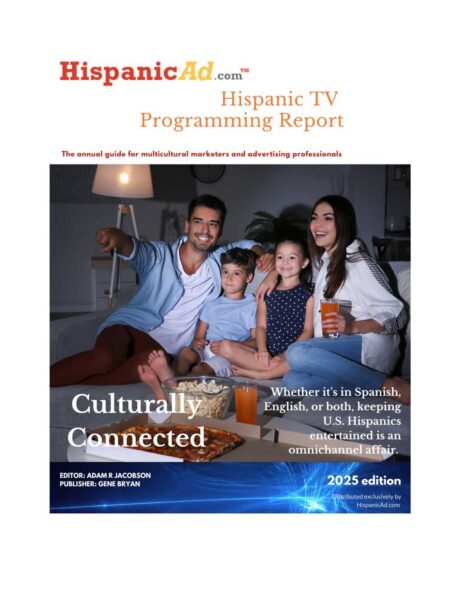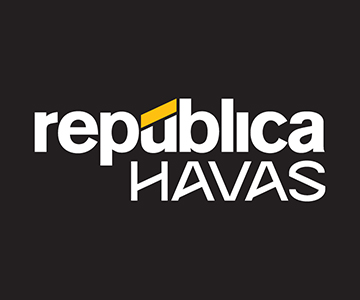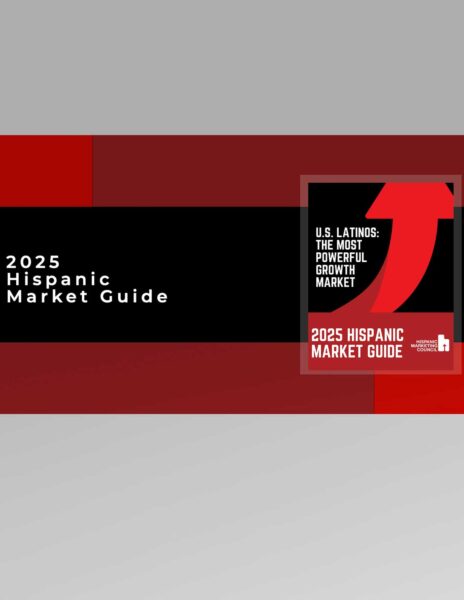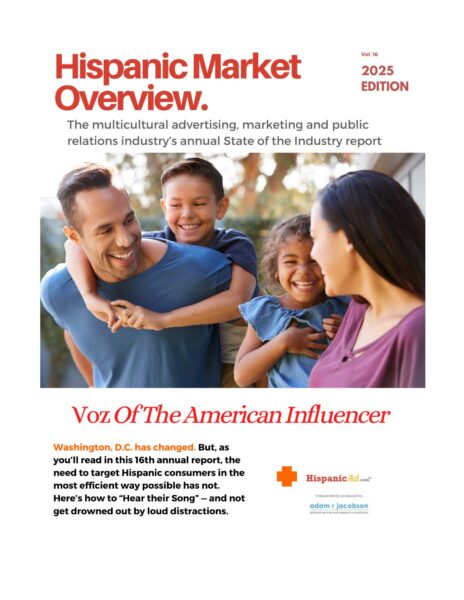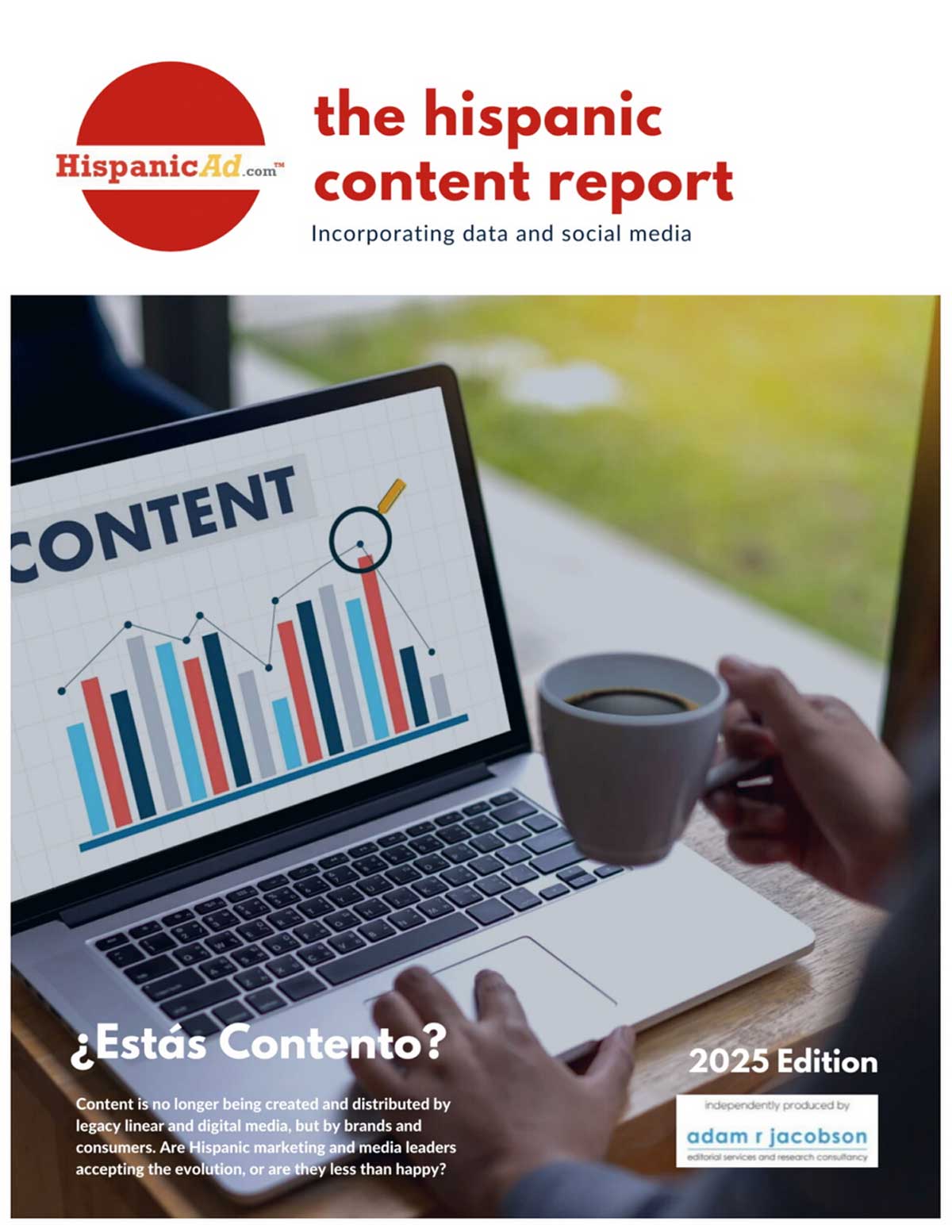Pablo Buffagni honored as best US Hispanic Creative at El Ojo de Iberoamérica 2014.
 Pablo Buffagni, Creative Director and Head Chef at BBQ Agency, has just been honored as the best US Hispanic Creative Director at El Ojo de Iberoamérica awards 2014, based on the creative work he led before the recent launch of his new agency. He had won last year as well, while working for Grupo Gallegos, and in the past when we was at Conill Saatchi & Saatchi and Bromley.
Pablo Buffagni, Creative Director and Head Chef at BBQ Agency, has just been honored as the best US Hispanic Creative Director at El Ojo de Iberoamérica awards 2014, based on the creative work he led before the recent launch of his new agency. He had won last year as well, while working for Grupo Gallegos, and in the past when we was at Conill Saatchi & Saatchi and Bromley.


 An industry-wide initiative, led by the trade group AHAA: The Voice of Hispanic Marketing, seeks to get more granular into advertisers ROI measures of the Hispanic market. A new study, Refining Hispanic ROI, released today by AHAA finds that the rapid shifts in the Hispanic market coupled with the emergence of the Total Market Approach, demand that sales data and television measurement methods evolve or new models emerge to give marketers an accurate read on their Hispanic ROI.
An industry-wide initiative, led by the trade group AHAA: The Voice of Hispanic Marketing, seeks to get more granular into advertisers ROI measures of the Hispanic market. A new study, Refining Hispanic ROI, released today by AHAA finds that the rapid shifts in the Hispanic market coupled with the emergence of the Total Market Approach, demand that sales data and television measurement methods evolve or new models emerge to give marketers an accurate read on their Hispanic ROI. Univision Communications Inc. announced the launch of Novelas Xpress, abridged versions of popular telenovelas that deliver all the drama and passion of the original stories – in smaller and more concentrated packages –15 hours in total length or less.
Univision Communications Inc. announced the launch of Novelas Xpress, abridged versions of popular telenovelas that deliver all the drama and passion of the original stories – in smaller and more concentrated packages –15 hours in total length or less. Entravision Communications Corporation announced that it will host the first “Noche de Locura con Erazno y La Chokolata” on Wednesday, November 19, 2014. This exclusive event, taking place at the Showrooom at Planet Hollywood in Las Vegas, Nevada, is in commemoration of the city of Las Vegas declaring November 23rd as the official Erazno y La Chokolata Day and celebrating eleven years since the show’s inception. The inaugural “Noche de Locura” will be hosted by Oswaldo Diaz, the vibrant performer and star of the hit radio program El Show de Erazno y La Chokolata, and will include special guest performances from the hottest regional Mexican artists including Calibre 50, Voz de Mando, Banda Carnaval and Remmy Valenzuela. Doors open at 7 p.m.
Entravision Communications Corporation announced that it will host the first “Noche de Locura con Erazno y La Chokolata” on Wednesday, November 19, 2014. This exclusive event, taking place at the Showrooom at Planet Hollywood in Las Vegas, Nevada, is in commemoration of the city of Las Vegas declaring November 23rd as the official Erazno y La Chokolata Day and celebrating eleven years since the show’s inception. The inaugural “Noche de Locura” will be hosted by Oswaldo Diaz, the vibrant performer and star of the hit radio program El Show de Erazno y La Chokolata, and will include special guest performances from the hottest regional Mexican artists including Calibre 50, Voz de Mando, Banda Carnaval and Remmy Valenzuela. Doors open at 7 p.m. Through Custom 360 Integrations, MetroPCS is a Brand Partner in Estrella TV’s Tengo Talento. This season long partnership with Tengo Talento, Mucho Talento will be highlighted through three primary elements: The MetroPCS Call Home Segment, MetroPCS Lounge and MetroPCS as Voting Partner.
Through Custom 360 Integrations, MetroPCS is a Brand Partner in Estrella TV’s Tengo Talento. This season long partnership with Tengo Talento, Mucho Talento will be highlighted through three primary elements: The MetroPCS Call Home Segment, MetroPCS Lounge and MetroPCS as Voting Partner. Hispanic consumers tend to feel they are not doing as well as in the past but anticipate that the growing economy will help improve their situation, according to the latest Hispanic consumer confidence index by the Florida Atlantic University Business and Economic Polling Initiative (FAU BEPI).
Hispanic consumers tend to feel they are not doing as well as in the past but anticipate that the growing economy will help improve their situation, according to the latest Hispanic consumer confidence index by the Florida Atlantic University Business and Economic Polling Initiative (FAU BEPI). ‘Tis the season to be shopping! With the holidays quickly approaching and Black Friday, Cyber Monday, and other retail-centric extravaganzas on the horizon, many people are beginning to plan their shopping sprees. And on how many lists will toys appear this year? Just over half of all Americans (51%) plan to purchase toys as gifts this year, nearly consistent with last year’s intent (50%). Not surprisingly, parents of a child under the age of 18 are twice as likely to purchase toys as those without children under the age of 18 (82% vs. 41%, respectively).
‘Tis the season to be shopping! With the holidays quickly approaching and Black Friday, Cyber Monday, and other retail-centric extravaganzas on the horizon, many people are beginning to plan their shopping sprees. And on how many lists will toys appear this year? Just over half of all Americans (51%) plan to purchase toys as gifts this year, nearly consistent with last year’s intent (50%). Not surprisingly, parents of a child under the age of 18 are twice as likely to purchase toys as those without children under the age of 18 (82% vs. 41%, respectively). As I reflect on this year’s Association of National Advertisers (ANA) Multicultural Marketing conference, we have come a long ways over the last 30 years, while our industry continues its struggle to sort out the optimal way to go to market in an increasingly diverse nation. First, I want to congratulate the ANA and specifically Gilbert Davila for keeping the subject of race and diversity in the forefront of how we go to market in the 21st century; because, America has never been comfortable in discussing race and ethnicity. In fact, the election of an African American to President of the United States has moved our discussion forward in so many ways. By Ernest Bromley is Chairman/CEO of Bromley Communications, LLC.
As I reflect on this year’s Association of National Advertisers (ANA) Multicultural Marketing conference, we have come a long ways over the last 30 years, while our industry continues its struggle to sort out the optimal way to go to market in an increasingly diverse nation. First, I want to congratulate the ANA and specifically Gilbert Davila for keeping the subject of race and diversity in the forefront of how we go to market in the 21st century; because, America has never been comfortable in discussing race and ethnicity. In fact, the election of an African American to President of the United States has moved our discussion forward in so many ways. By Ernest Bromley is Chairman/CEO of Bromley Communications, LLC. Experian Marketing Services published a new research report today that reveals the key marketing strategies, tactics and trends that will define the 2014 holiday season.
Experian Marketing Services published a new research report today that reveals the key marketing strategies, tactics and trends that will define the 2014 holiday season. If you thought being an advertising film producer is a high pressure job, read on. From California to South Florida via Mississippi, Vietnam, Oregon & New York. Now that’s a life journey. By Gonzalo López Martí – LMMIAMI.COM
If you thought being an advertising film producer is a high pressure job, read on. From California to South Florida via Mississippi, Vietnam, Oregon & New York. Now that’s a life journey. By Gonzalo López Martí – LMMIAMI.COM Azteca America announced four new additions to its executive roster. Gary Pacheco joins the network as Station Manager of WMBC-Azteca New York, Erin Cook joins as Vice President of Network and National Spot Sales in Dallas, Joe Jaime joins the Chicago office as Vice President of Network and Spot Sales – Midwest, and Thomas Andre joins as an Account Manager in the Glendale, Calif. office.
Azteca America announced four new additions to its executive roster. Gary Pacheco joins the network as Station Manager of WMBC-Azteca New York, Erin Cook joins as Vice President of Network and National Spot Sales in Dallas, Joe Jaime joins the Chicago office as Vice President of Network and Spot Sales – Midwest, and Thomas Andre joins as an Account Manager in the Glendale, Calif. office. Most marketers are behind when it comes to investing in the Hispanic market. Of the $171 billion spent on paid media in 2013 (according to eMarketer), Hispanic media spending totaled just $8.3 billion (according to Kantar and AdAge). Hispanic media spending represents less than 5 percent of total paid media spending, while Hispanics represent 17.1 percent of the U.S. population. While paid media doesn’t capture the entirety of marketing activity targeted to Hispanics, it provides a good barometer. By Jose Villa / Sensis
Most marketers are behind when it comes to investing in the Hispanic market. Of the $171 billion spent on paid media in 2013 (according to eMarketer), Hispanic media spending totaled just $8.3 billion (according to Kantar and AdAge). Hispanic media spending represents less than 5 percent of total paid media spending, while Hispanics represent 17.1 percent of the U.S. population. While paid media doesn’t capture the entirety of marketing activity targeted to Hispanics, it provides a good barometer. By Jose Villa / Sensis








